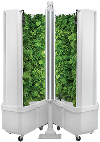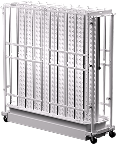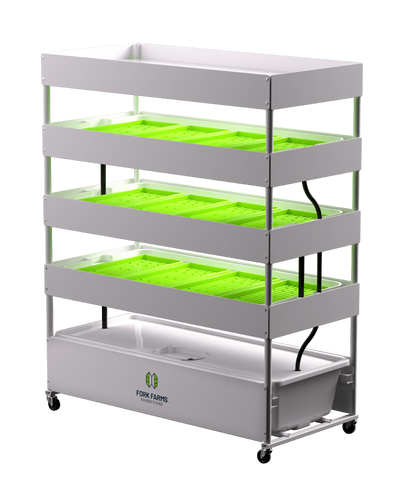Why Hydroponic Gardens Are a Great Idea for Food Banks And Community
A food bank is a distribution center or a hub where donated food is collected and then distributed to food pantries. All of the food collected is intended to go to people facing hunger or food insecurity and the vast majority of the food that gets donated to food banks comes from large big box retailers like Walmart or Kroger.
The issue that food banks face is the fact that the majority of the fresh food that is donated is typically past its “best buy” date or peak, meaning its nutrition quality is often quite low. It is an ongoing challenge to figure out how to get fresh food into the hunger relief system as fresh food can spoil and bruise quickly, and lose its nutritional value within hours. The good news is that the industry is currently focused on how to make positive changes to be able to feed people fresh, nutritious food instead of processed and shelf-stable foods.
Creativity is Key
- Food banks could create local food purchasing programs where they get grant funding to buy produce direct from a local farmer in season or to buy their “seconds”
- Food banks could encourage local growers to grow a bit more this year specifically for those in need. A great example of this community-driven type of program is Grow a Row for St. Joe where in 2023, families and businesses donated more than 55,000 pounds of fresh produce to those in need
- Tap into Federal Programs like WIC and Supplement Nutrition Assistance Program (SNAP) that provide funding to families to buy food at peak quality at the grocery store
- Research double buck programs at farmers markets. Different states have their own resources around this, so google your town and double buck farmers market program to find more information
- Adopt a hydroponic growing system for efficient, cost-effective, reliable fresh food year-round. You can read more here on how to get started with a hydroponics growing system.
A Hydroponic Gardens is an Excellent Idea for Food Banks for Many Reasons
Hydroponics in a food bank setting is like giving the community a fishing pole as opposed to giving people a fish. The best hydroponic garden for a food bank depends on several factors including space, budget, scale of operation, and needs of the food bank. In general, Vertical Farming Systems or Tower Gardens tend to be ideal for food banks as they offer a balance of efficiency, scalability, and ease of use. These systems maximize space, are easy to maintain, and can reliably produce a variety of fresh foods year-round, making them an ideal choice to enhance food security and build community. It is also important to point out that grant opportunities exist for hunger relief organizations to support indoor hydroponic growing all across the country, so these should be explored.
By leveraging the benefits of hydroponics, food banks can help combat food insecurity, promote health, a better diet, and foster community engagement, all while minimizing environmental impact.
- Year-Round Production - Hydroponic gardens can operate year-round, regardless of climate changes, natural disasters, and seasonality. This uninterrupted production means food banks can provide fresh vegetables and fruits to those in need throughout the entire year, helping to combat food insecurity more effectively.
- Efficient Use of Space - Vertical farming maximizes the use of space. Food banks can set up hydroponic gardens in small spaces such as unused warehouse areas, basements, large closets, etc. to ensure a consistent supply of fresh, quality produce.
- High Yield and Fast Growth - Hydroponic systems often result in faster plant growth and higher yields compared to traditional soil farming due to the fact that they are grown in a controlled environment. Plants receive a perfect balance of nutrients and water, which optimizes their growth. This efficiency means that food banks can produce more food in a shorter amount of time, enhancing their capacity to serve their communities. A Flex Farm can grow 25 pounds of lettuce every 28 days.
- Nutritional Benefits - As mentioned above, access to fresh, nutritious produce is often limited for food bank clients. Hydroponic gardens can provide a reliable source of nutrient-dense fresh foods such as: leafy greens, herbs, tomatoes, peppers, cucumbers and more, improving the overall health of those who rely on food banks.
- Educational Opportunities - Hydroponic gardens can serve as educational tools. They provide a hands-on learning experience about sustainable agriculture, science, nutrition, and community. Food banks can involve volunteers and clients in the gardening process, teaching valuable real-life skills, job training, providing a sense of ownership and responsibility, and fostering a sense of community.
- Reduced Transportation and Storage Costs - Transportation and food storage are significant cost factors for food banks. Growing food on-site with a hydroponic farm reduces the need for both of these things, lowering overall operational costs. Food grown on-site is also fresher since it is grown locally and does not have to travel thousands of miles to get from farm to plate
- Scalability - Hydroponic systems can be easily scaled up or down depending on the food bank’s needs and resources. Many systems offer easy options to link systems together to produce more fresh food at a faster pace.
Explore Examples of Hydroponics and Food Banks Growing in Action
We know of numerous food bank partners that use hydroponic farms to feed their communities with great success. Read more below about these amazing organizations and their growing farms.
- Ozaukee Food Alliance in Saukville, WI serves more than 400 families each month
- Grow it Forward in Manitowoc, Wisconsin produces 1,000 servings of healthy, leafy greens per grow cycle (25-28 days) year-round
- Nourish in Bridgeport, CT - Connecticut’s first non-profit Indoor Hydroponic Farm that is growing produce to distribute to its neighbors in need.
- The Food Basket on the Island of Hawai'i - ending hunger since 1989.
- Heavens Windows in San Diego - serving close to 150,000 meals to those in need.
Hydroponic growing systems are ideal for food banks to help serve fresh, healthy foods to the greatest number of those in need quickly, efficiently, sustainably, and with communities top of mind. Contact one of our team members to learn more about this topic and/or any of our amazing food bank partners who work tirelessly to help feed fresh, nutritious food to those in need. Thank you to all give back each day.
Important Links:
























